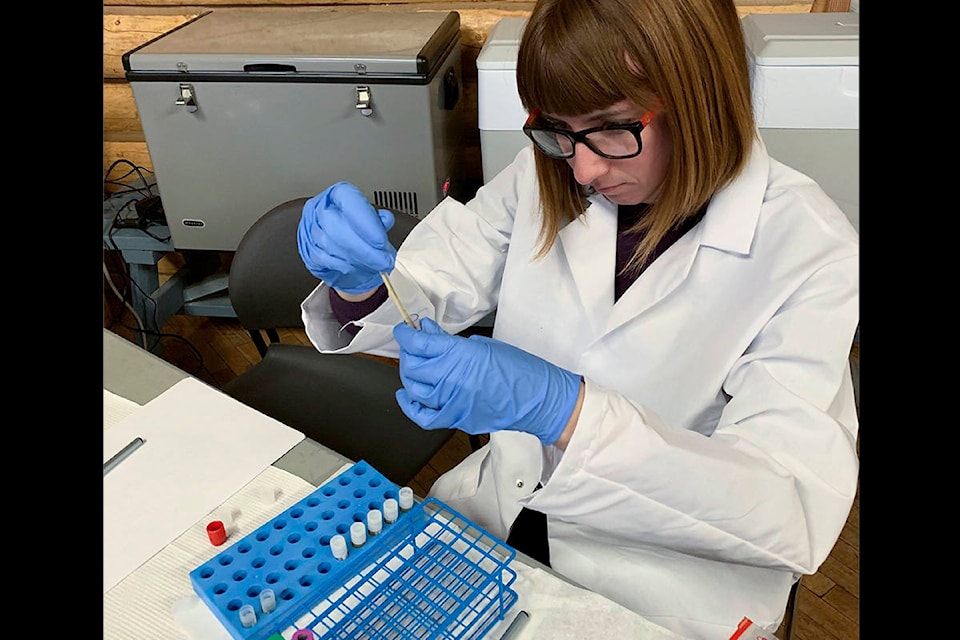The leaders of a study on contaminants and traditional foods in Old Crow have one message for residents — keep eating what you’re eating, because for the most part, contaminants aren’t an issue.
“My message is, just continue to eat fish and wildlife, you know, like caribou, moose and the various species of fish,” Vuntut Gwitchin Government executive director William Josie said in an interview Jan. 21.
“It’s very healthy, don’t stop eating it. It tastes good and it’s healthy.”
Josie was speaking the week after members of a research team from the University of Waterloo, as well as longtime Yukon researcher Mary Gamberg, visited Old Crow to present the results of a study led by the Vuntut Gwitchin Government that began last year.
Researchers travelled to Old Crow to collect blood, hair and urine samples from residents, who also filled out two surveys on their lifestyle (age, work history and smoking habits, for example) and traditional food consumption (what they were eating, how much, and how often).
A total of 77 residents, or about a third of Old Crow’s population, participated in the study.
Mallory Drysdale, a student at the University of Waterloo who worked on the study as part of her PhD, said in an interview Jan. 20 that researchers were happy to find that contaminant levels for things like mercury, cadmium and pesticides in Old Crow citizens were similar to those measured in other Canadian studies.
However, researchers also found that the average blood lead levels in participants were higher than found in similar studies, and there were also “measurable concentrations” of persistent organic pollutants like DDT and toxaphene, despite the fact that they were banned in 2001.
While the vast majority of participants had contaminant levels well below available health guidelines — meaning that while the contaminant is present, it’s not posing an adverse health risk — Drysdale said a small handful of people were found to have blood lead levels above health guidelines.
“But even those levels, they are under the levels … associated with immediate health problems,” she explained. “These are levels that might just pose a risk over time, so if we can start decreasing exposure now, we can potentially decrease those risks.”
Drysdale said researchers will be doing follow-up tests with those participants in particular, whom she said made up less than five per cent of the total participant pool. The University of Waterloo team will also be taking a closer look at the various contaminants found in the blood, urine and hair samples and cross-referencing them with the surveys citizens completed to try and identify the potential exposure sources.
While it hasn’t been confirmed, Josie, who himself participated in the study, said he thinks the lead may be coming from lead bullets, which some Vuntut Gwitchin citizens still use for hunting. He also suggested that smoking or natural sources might also be contributing to the higher-than-average blood lead levels.
In a separate interview, Gamberg, who has long studied contaminants in the Porcupine caribou herd and also assisted the Vuntut Gwitchin Government with a fish study a few years ago, said she wasn’t sure the lead was coming from residents’ diets. In those previous studies, she noted, neither the caribou nor fish showed high levels of lead.
“I would be surprised if it came from food, actually,” she said.
Drysdale, Gamberg and another member of the research team returned to Old Crow Jan. 13 to give presentations on their overall findings, and were also available throughout the week to give participants their individual results.
Josie, who himself participated in the survey (he described his results as “good”), said he thinks that residents are feeling “pretty good” with the study and the results.
The fish study with Gamberg, he said, “woke up” a lot of people to the issue of contaminants in their food, with mercury the main concern in that study due to the bioaccumulation of the metal in long-living fish like inconnu, pike and lingcod. It was that fish study and the concerns about contaminants it raised that caused the government to pursue a larger, human biomonitoring study.
While the government has issued guidelines on consumption for some animal organs and fish, overall, Josie said, it’s encouraging people to keep incorporating traditional foods into their diets.
“Keep eating traditional foods,” he said. “There’s nothing wrong with it.”
Drysdale agreed with that advice.
“The health benefits of traditional food outweighs the health risks of contaminants,” she said.
Contact Jackie Hong at jackie.hong@yukon-news.com
This story has been edited to correct incorrect caption information. It has also been edited to remove an incorrect reference to VGG’s recommended guidelines for fish and caribou organs. The News regrets the errors.
